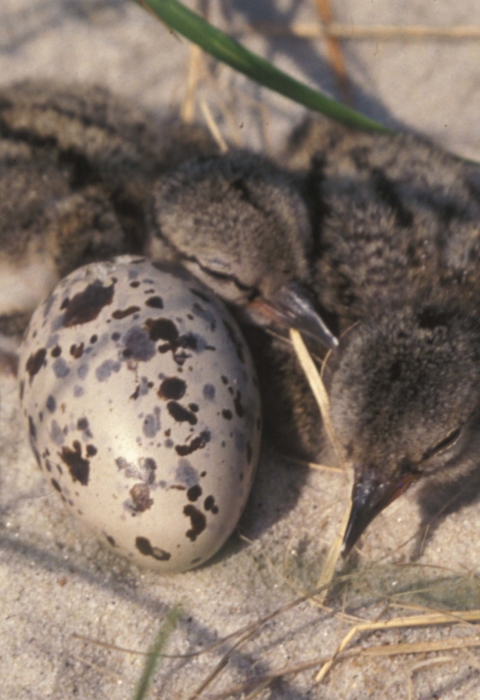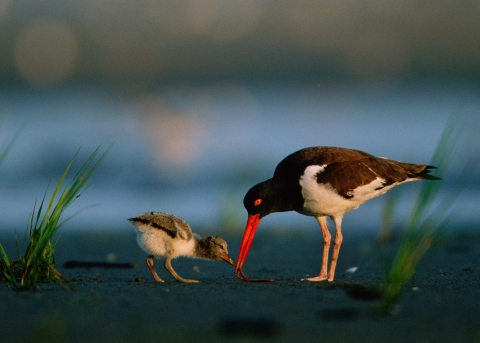Fifteen years ago, things just weren’t adding up for American oystercatcher — beyond its physical proportions, that is. The conspicuous shorebird has a mallard-sized body, a crow-sized head, and a long orange bill reminiscent of a peeled carrot.
Population numbers were down, said Shiloh Schulte, American oystercatcher recovery coordinator for the Manomet Center for Conservation Sciences. “The metrics showed reproduction seemed to be declining: very few chicks were being produced.”
A drop in reproductive success might cause concern for any species, but it was particularly alarming for a bird whose offspring usually don’t reach maturity. Most eggs fall victim to predators and flooding. If they do hatch, young oystercatchers often don’t live long enough to reproduce, which first occurs around three or four years of age.
The species has evolved to compensate for this loss of eggs and juveniles, explained Caleb Spiegel, a biologist with the U.S. Fish and Wildlife Service: “It is a long-lived shorebird, and when they do make it to adulthood, they tend to survive and have a lot of chances to reproduce.” But the drop in reproductive success was changing the species’ population equation. There was an increasingly smaller cohort of young oystercatchers, facing the same long odds of survival.
To address the decline, shorebird scientists had to resolve another numbers problem. Information on oystercatcher population trends came primarily from state and local surveys, which often varied in methodology and coverage. Without consistent data across the range of the species, scientists couldn’t calculate the population trajectory. They needed a baseline estimate.
So in the winter of 2003, scientists from Manomet took to the skies to survey for birds over the species entire non-breeding range — New Jersey to Texas — on behalf of the American Oystercatcher Working Group, a group of scientists and managers who had come together two years earlier to coordinate conservation for the species. They counted about 11,000 birds.
Given declining reproduction, and diminishing habitat — oystercatchers rely on the thin strip of sandy coastline, which is only getting thinner in the face of development and sea-level rise — scientists knew that there wouldn’t be enough birds to sustain the population over time.
They also knew the numbers problem indicated an overarching challenge: they couldn’t change the trajectory without scaling up the response.
“The working group had been studying the birds and doing some small projects since 2001, but we weren’t operating at a large enough scale to have any real conservation impact,” Schulte said.
They were already taking measures like surveying, monitoring, controlling predators, managing disturbances by people, and restoring habitat. “But we weren’t doing them across a big enough range,” Schulte said.
They didn’t just need a bigger plan. They needed a business plan.
Changing the picture
Think back on the first time you picked up an Etch A Sketch, and gripped the small white knobs between each thumb and forefinger. Maybe you tried turning the knobs independently at first, maybe you tried turning them at the same time. Eventually, you learned how to control what appeared on the screen by carefully manipulating those knobs. You made lines, you wrote your name, maybe you drew a respectable cat.
About a decade ago, when things looked bleak for American oystercatcher, staff in the Service’s Migratory Birds program started thinking about how they might turn the knobs to predictably change the picture for this species.
One of the biggest threats to oystercatcher is nest predation, but targeted measures to control predators in nesting areas have produced consistent results. So they used those data to do some math. How many nests do we need to protect to see a meaningful rise in productivity? And how much would that cost?
By linking actions to outcomes and expenses they developed a whole new way of implementing conservation. Working closely with shorebird experts from the American Oystercatcher Working Group, they devised a different kind of plan: a business plan.
Assuming the role of the conservation entrepreneur, the Service led the working group in fleshing out the plan, outlining what needed to happen where to increase the oystercatcher population, and at what price, and pitched it to an interested investor — the National Fish and Wildlife Foundation.
“Working with the Service and the Foundation, we came up with a goal of a 30-percent increase in the population over ten years, as well as a set of specific conservation actions,” Schulte said. “Basically, what we would like to do if we had the resources, and what kind of scale we would like to work at.”
In the context of conservation, this was a novel approach. “They were linking concrete management objectives to actual funding levels,” Spiegel said. “That’s challenging because the environment is inherently unpredictable, but it’s what funders want to see when they are looking for a return on investment.”
It worked. NFWF agreed to put up five million dollars over ten years. With a roughly 1 to 1 match, that has amounted to about one million a year toward oystercatcher conservation since 2009.
And it has paid off. In less than a decade, the oystercatcher population has increased 23 percent as a result of strategic investments and action — early intervention changed the trajectory for a species that was on the brink of population bankruptcy.
As the coordinator of the plan, Schulte explained, “My job has been to network the group to share resources, information, training, and to make sure we don’t repeat each others’ mistakes.”
Just as important, networking has made it possible for them to learn from each others’ successes.
Take predator management. By providing a mechanism for disseminating information, the working group has helped partners address one of the major causes of nest failure: raccoons, coyotes, feral cats, foxes, and other carnivores that eat oystercatcher eggs, and whose populations have experienced unnatural booms along the coast because of human activities.
Georgia Department of Natural Resources biologist Tim Keyes, who joined the working group in 2011, has helped to advance predator management in his state by spearheading the Georgia Shorebird Alliance, which addresses needs for species with overlapping habitat, and threats, like least tern and Wilson’s plover, in addition to oystercatcher.
Working across jurisdictions to coordinate monitoring for predators at different sites, and sharing information about effective techniques for controlling them, Georgia has established a united front. “Now when predation happens on our coast, we are able to mobilize and tackle it head on,” Keyes said.
Thanks to the working group, shorebird managers in other states have also benefited from these lessons learned, which are distributed through email updates and in presentations at an annual meeting.
“It has been a huge boon for us too,” Keyes added, explaining that before piloting a new tactic, they can ask around to see if anyone else has already tried it.
“Georgia may not ever be the production engine for oystercatcher population on the Atlantic coast, but we have certainly made significant strides in improving productivity through predator control efforts,” he said.
That’s exactly why the business plan has been such a success: no single state should be the “production engine” for a species that ranges from New England to Central America. By forming a sort of horizontal alliance, partners have been able to pool resources and knowledge to improve their shared position — the position of oystercatchers.
“They were really forward thinking,” Spiegel said. “They saw that the problems the species was experiencing could not be solved by only thinking about conservation at the site level. Now we are seeing the results, and it’s inspiring.”
He means that literally. Based on the success of the American oystercatcher business plan, NFWF is now supporting a broader, multi-species effort. The Atlantic Flyway Shorebird Initiative aims to increase the populations of 15 focal shorebird species by 10 to 15 percent over a 10-year period.
“When we started to look at population trends across the Atlantic Flyway, we realized about half of these species were declining,” Spiegel explained. “It was a wake-up call to be more coordinated in our management and conservation efforts.”
Although a strategy covering 15 species, some of which only spend a short time in the United States during their fall or spring migrations, is aspirational, it’s also essential. Atlantic Flyway Shorebird Initiative partners now span several countries from Tierra Del Fuego to the Arctic.
“Shorebirds are already living on the edge,” Spiegel said. “We need an international partnership to be working together throughout the life cycle of these species based on common goals and metrics, and the oystercatcher working group has been a model for how to do that well.”
To see how other partners are now linking investments to outcomes, check out the Atlantic Flyway Shorebird Initiative story map.





